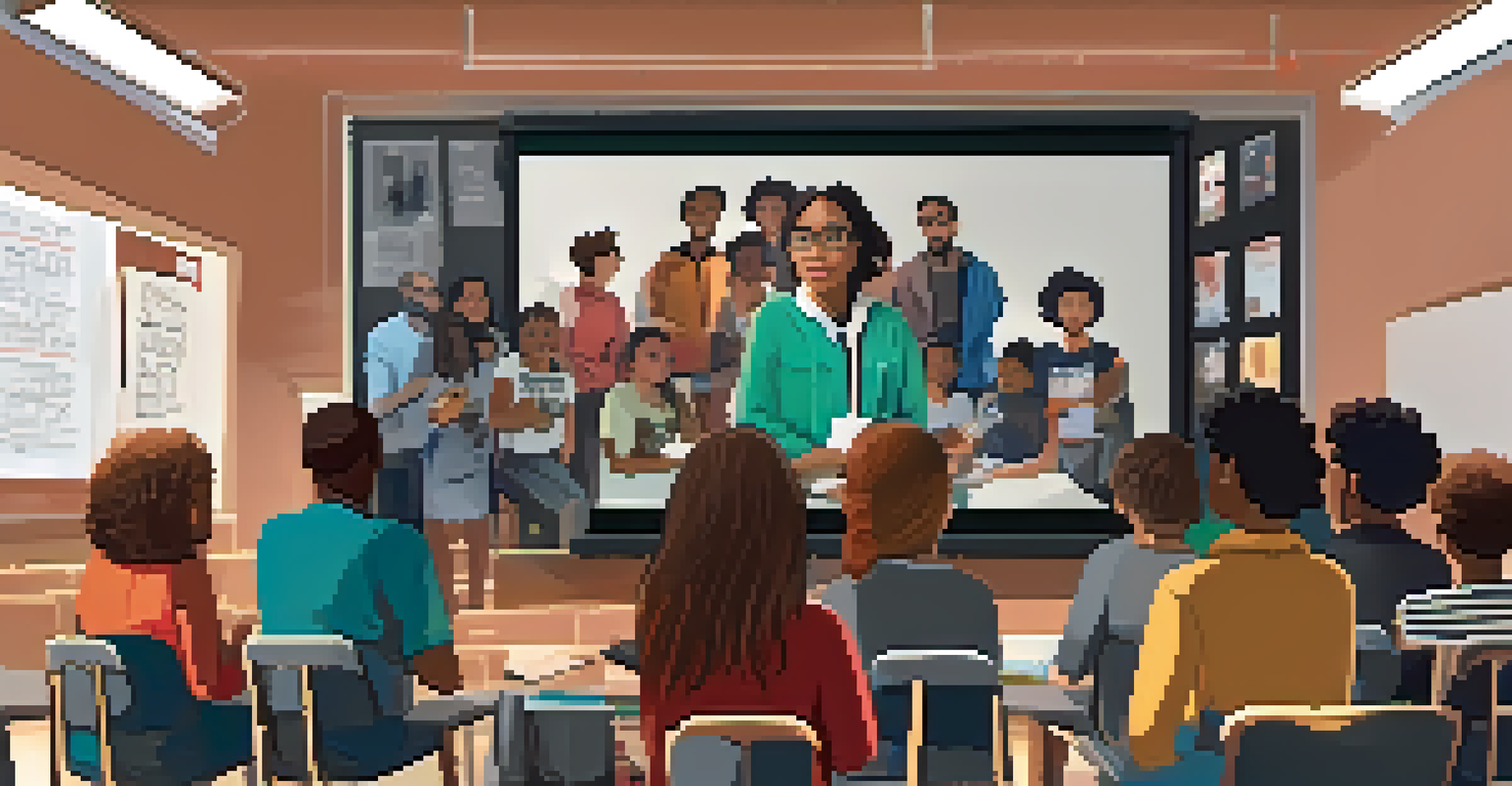Addressing Gender and Racial Disparities in Film Production

Understanding the Current Landscape of Film Production
Film production has long been criticized for its lack of diversity, particularly concerning gender and race. Statistics show that women and people of color are significantly underrepresented in key roles like directors, writers, and producers. This disparity not only affects the stories being told but also perpetuates stereotypes and limits opportunities for diverse talent.
Diversity is being invited to the party; inclusion is being asked to dance.
For instance, a study revealed that women directed only 12% of the top 250 grossing films in recent years. Similarly, representation of people of color in leading roles and behind the camera remains alarmingly low. Understanding these statistics is crucial to recognizing the gaps that need addressing in the industry.
By acknowledging the current landscape, we can start to identify the systemic barriers that contribute to these disparities. This knowledge serves as a foundation for creating actionable solutions to promote inclusivity and equality in film production.
The Impact of Gender and Racial Disparities on Storytelling
The underrepresentation of diverse voices in film not only affects industry professionals but also influences the stories we see on screen. When a limited group of individuals controls the narrative, it often leads to a narrow portrayal of experiences and cultures. This lack of diversity can perpetuate harmful stereotypes and alienate audiences.

Consider the difference in storytelling when women and people of color are involved in the creative process. Films that include diverse perspectives tend to be more relatable and resonate with broader audiences. This highlights the importance of including a variety of voices in film production to enrich storytelling.
Diversity is Lacking in Film Roles
Women and people of color are significantly underrepresented in key film production roles, impacting the narratives being told.
Moreover, diverse storytelling fosters empathy and understanding among viewers. By addressing these disparities, the industry can create a more inclusive environment that reflects the richness of our society and enriches the cinematic experience.
Barriers to Entry for Women and People of Color
Several barriers exist that hinder women and people of color from entering the film industry. These include lack of access to funding, mentorship, and networking opportunities. Additionally, biases and stereotypes can create an unwelcoming environment, making it challenging for newcomers to break into the field.
If we want to change the world, we must start by changing the way we tell stories.
For example, many aspiring filmmakers struggle to find investors willing to back their projects due to preconceived notions about their capabilities. This can lead to a cycle where only established filmmakers, often white males, receive the support they need to succeed. Breaking down these barriers is essential for creating a more equitable industry.
Recognizing these obstacles is the first step toward dismantling them. By providing resources, mentorship programs, and inclusive networks, the film industry can help pave the way for a more diverse pool of talent.
Initiatives Promoting Diversity in Film Production
In recent years, various initiatives have emerged to address gender and racial disparities in film production. Organizations like the Geena Davis Institute on Gender in Media focus on promoting gender equality in media representation. Similarly, initiatives like the Sundance Institute’s ‘Catalyst’ program aim to support filmmakers from underrepresented backgrounds.
These programs often provide funding, mentorship, and training to help aspiring filmmakers navigate the industry. They foster connections between experienced professionals and emerging talent, creating a more inclusive community. By investing in these initiatives, the industry can foster a new generation of storytellers.
Barriers Hinder Diverse Talent Entry
Obstacles such as lack of funding and mentorship create challenges for women and people of color trying to enter the film industry.
Moreover, these efforts not only benefit individuals but also enhance the overall quality of films produced. Diverse perspectives lead to richer narratives, ultimately attracting wider audiences and driving box office success.
The Role of Studios and Production Companies
Studios and production companies play a crucial role in promoting diversity within film production. By actively seeking to hire women and people of color in leadership roles, they can create a more inclusive environment. This shift requires a commitment to reevaluating hiring practices and prioritizing diversity in their productions.
For instance, companies like Netflix have made significant strides by establishing diversity and inclusion initiatives, resulting in a more varied slate of projects. These efforts are not just about meeting quotas; they are about recognizing the value of diverse teams in driving creativity and innovation.
When studios embrace diversity as a core value, they set a precedent for the entire industry. This commitment can lead to lasting change, as other companies follow suit and prioritize inclusivity in their hiring and production processes.
Empowering Diverse Talent through Education and Training
Education and training are key components in empowering women and people of color in the film industry. By providing access to quality education and resources, aspiring filmmakers can develop their skills and build confidence. Programs that focus on technical training, storytelling, and business acumen are essential for nurturing diverse talent.
Moreover, mentorship plays a vital role in guiding newcomers through the complexities of the industry. Experienced professionals can share insights, offer advice, and provide networking opportunities that can be invaluable for emerging filmmakers. This support fosters a sense of community and encourages collaboration.
Initiatives Foster Inclusion in Film
Programs aimed at promoting diversity provide valuable resources and support for underrepresented filmmakers, enhancing the industry as a whole.
As educational institutions and organizations prioritize diversity in their programs, they can help cultivate a more inclusive pipeline of talent. This investment in education not only benefits individuals but also enriches the film industry as a whole.
The Future of Film: A Call for Inclusivity
As we look to the future of film, it's clear that inclusivity must be at the forefront of industry conversations. The demand for diverse stories and perspectives is growing, and audiences are increasingly seeking content that reflects their own experiences. This shift presents an opportunity for the film industry to evolve and embrace change.
To achieve a more inclusive future, everyone in the industry must commit to addressing gender and racial disparities. This includes not only hiring practices but also storytelling, funding, and support for underrepresented voices. A collaborative effort can lead to meaningful progress and create a more equitable landscape.

Ultimately, the goal should be to create a film industry that celebrates diversity and fosters a sense of belonging for all. By embracing inclusivity, we can ensure that the stories we tell are as rich and varied as the world we live in.